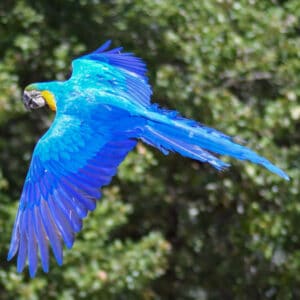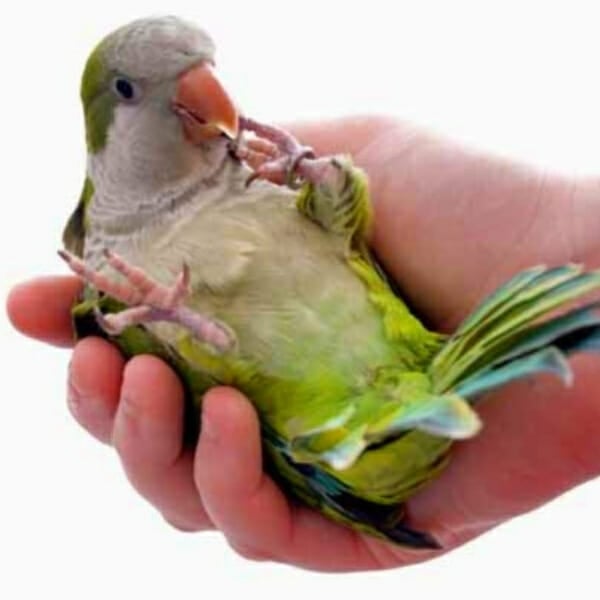
The Quirky Quaker Parrot: Energy, Skills, Personality
Last Updated on by Mitch Rezman
If you’ve ever dreamed of having a pet that’s equal parts comedian, chatterbox, and feathery cuddle bug, let me introduce you to the quaker parrot.
Also known as the monk parakeet, this pint-sized parrot is a big personality wrapped in a small, green-and-gray package.
But don’t let their modest size fool you—quaker parrots are the drama queens (and kings) of the bird world, and they’re here to steal your heart…and maybe your snacks.
What Makes the Quaker Parrot So Special?
First things first: these birds are *smart*. Like, “figure out how to open their cage and raid your pantry” smart. Quakers are known for their problem-solving skills and their ability to mimic human speech with startling accuracy. If you’ve ever wanted a pet that can greet you with a cheerful “Good morning!” or sass you with a sarcastic “Really?” when you’re late with their dinner, this is your bird.
Blue Quaker playing with black S hook ~ Video
But it’s not just their intelligence that makes quakers stand out—it’s their attitude. These parrots have an uncanny ability to make everything they do seem like a performance. Whether they’re hanging upside down from their cage like a tiny acrobat or tossing their toys around with dramatic flair, quakers know how to keep you entertained.
Meet the Monk: Appearance and Origins
Native to the temperate and subtropical regions of South America, quaker parrots have made themselves at home around the world thanks to both intentional releases and escapees establishing feral colonies. Their adaptability is legendary—these birds can survive in climates ranging from the chilly streets of Chicago to the balmy neighborhoods of Florida.
Visually, they’re quite the distinctive package. At about 11-12 inches long, quakers sport bright green backs and wings, contrasting with their gray breasts, throats, and cheeks. This gray patch creates the appearance of a clerical robe, hence their “monk parakeet” nickname. Their dark eyes gleam with intelligence, set in a face that somehow always seems to be plotting something (usually mischief).
The Quaker’s Love Language: Chatter and Cuddles
Quaker parrots are social butterflies who thrive on interaction. They’ll happily spend hours perched on your shoulder, chirping in your ear about all the latest bird gossip (or perhaps critiquing your choice of TV shows). And while they can be independent at times, quakers are also big fans of snuggling. Yes, you read that right—these birds *love* to cuddle. Just be prepared for them to nuzzle into your neck and claim you as their human.
Oh, and did I mention they’re foodies? Quakers have a knack for making you feel guilty about eating anything in front of them without sharing. Pizza? They want a bite. Fruit salad? Definitely theirs now. They’ll even eye your coffee like it’s the elixir of life (don’t give it to them, though—caffeine is a no-go for birds).
Talking the Talk: Vocal Abilities
When it comes to talking, quakers are overachievers. Despite their small size, they can develop vocabularies that rival those of much larger parrots. Many quaker owners report that their feathered friends have learned dozens, sometimes hundreds, of words and phrases. More impressively, they often use these words contextually—saying “goodbye” when you leave or “yum yum” when food appears.
Their vocal talents aren’t limited to human speech, either. Quakers are masterful mimics of household sounds, from the microwave beep to your ringtone (usually just as you’ve settled into the bathtub). They’ll also create their own signature sounds—little chirps, whistles, and clicks that become a unique language between you and your bird.
Home Sweet Home: Housing Your Quaker
Despite their compact size, quakers need spacious accommodations. These are birds that build massive communal nests in the wild—some weighing up to 200 pounds!—so don’t expect your quaker to be content in a tiny cage. At minimum, provide a cage measuring 24″ × 24″ × 24″, but bigger is always better.
Inside that cage, channel your inner interior designer.
Quakers appreciate a well-appointed home with multiple perches of varying diameters (great for foot health), numerous toys for chewing and foraging, and different zones for eating, playing, and sleeping. And just like the rest of us, they enjoy redecorating—be prepared for your meticulously arranged cage setup to be completely rearranged according to your quaker’s preferences.
Many quaker owners also create a dedicated “construction zone” with building materials like
- Strips of paper
- Ribbons
- Leather thongs
- Rope
- Shoe laces
This satisfies their natural nesting instinct and provides hours of entertainment as they engineer elaborate structures.
Dining with the Monks: Diet and Nutrition
A well-fed quaker is a happy quaker, and these birds need a varied diet to thrive. While commercial pellets should form the foundation (about 60-70% of their diet), fresh vegetables and fruits are essential supplements.
Leafy greens like kale and spinach, colorful veggies like bell peppers and carrots, and fruits like apples and berries will have your quaker doing their happy dance.
Some quakers develop strong food preferences (read: stubborn opinions about what constitutes acceptable cuisine). One day they might worship blueberries like tiny purple gods, and the next day look at them like you’ve offered a plate of dirt. The key is persistence and variety—keep offering healthy options, even when they give you the avian equivalent of an eye roll.
Seeds, while beloved by most quakers, should be limited to occasional treats due to their high fat content. Think of them as bird potato chips—delicious but not nutritionally complete. And speaking of treats, many quakers enjoy small portions of cooked pasta, whole grain toast, or even a bit of scrambled egg now and then.
Social Dynamics: Friends, Foes, and Family
Quakers are complex social creatures with intricate relationship needs. In the wild, they live in large colonies and maintain close bonds with their flock mates. As pets, they transfer this social nature to their human families.
If you’re their chosen person, congratulations! You’ll receive the full spectrum of quaker affection, including gentle beak nibbles (their version of kisses), regurgitated food offerings (a high honor in parrot culture, albeit somewhat gross), and devoted companionship. However, this devotion can sometimes manifest as jealousy—many quakers develop a “one-person bird” reputation, becoming possessive of their favorite human.
With other pets, results vary wildly. Some quakers establish surprising friendships with cats or dogs, while others declare full-scale war on any non-human that dares enter their territory. Introduction to other household pets should always be carefully supervised, remembering that your confident quaker might not realize they’re significantly smaller than your golden retriever.
As for other birds, quakers can be territorial despite their generally social nature. If you’re considering a multi-bird household, separate cages and supervised interaction time are usually advisable, at least initially.
Mental Gymnastics: Keeping Your Quaker Engaged
The quaker brain is like a tiny supercomputer constantly seeking input. Without adequate mental stimulation, these intelligent birds can develop behavioral problems including excessive screaming, feather plucking, or destructive chewing.
Fortunately, quakers are easy to entertain if you get creative. Food puzzles that make them work for treats, toys with parts to manipulate, and rotation of playthings to prevent boredom are all excellent strategies. Many quakers also enjoy learning tricks—teaching your bird to wave, turn around, or retrieve small objects can provide mental exercise while strengthening your bond.
Don’t underestimate the power of novelty, either. Introducing new experiences—like a supervised exploration of a different room or a bird-safe plant to investigate—can be the highlight of your quaker’s week.
The Not-So-Rosy Side: Challenges of Quaker Ownership
While quakers are delightful companions, they’re not without their challenges. Their vocalization, while entertaining, can reach impressive volumes—especially during their morning and evening “social hours.” If you have noise-sensitive neighbors or value complete silence, a quaker might test your patience.
Their longevity is another consideration—with proper care, these birds live 20-30 years. This is a decades-long commitment, potentially outlasting relationships, jobs, and housing situations. They’ll be with you through various life stages, requiring consistent care throughout.
And then there’s the mess. Quakers seem to operate on the principle that food, toys, and feathers should be distributed as widely as possible throughout your home. Investing in a good vacuum and developing a zen-like attitude toward the constant clean-up are valuable quaker owner skills.
Legal Considerations: The Controversial Quaker
Before bringing home a quaker parrot, it’s essential to check your local regulations. Because of their remarkable colony-building abilities and adaptability, quakers are classified as invasive species and prohibited or restricted in several states, including California, Georgia, Kansas, Kentucky, Hawaii, New Jersey, Pennsylvania, Tennessee, and Wyoming.
Even in states where they’re legal, some areas require permits or have additional restrictions. This isn’t because quakers are dangerous—it’s because they’re too good at surviving. Escaped or released quakers have established thriving feral colonies in numerous cities, sometimes causing agricultural concerns or competing with native species.
Responsible ownership includes understanding these legal considerations and ensuring your feathered friend stays safely within your home.
Final Thoughts: Life with a Feathered Comic
Living with a quaker parrot means never having a dull moment. These birds have a gift for turning ordinary days into adventures, whether they’re performing acrobatics with their toys, engaging in passionate conversations (with you or themselves), or simply watching the world with their uniquely critical bird perspective.
They’ll test your patience, violate your personal space, reorganize your priorities, and probably make you laugh more than you thought possible. They’ll greet you enthusiastically when you come home, comfort you when you’re sad, and judge you mercilessly when you eat the last cookie without sharing.
If you’re looking for a pet that’s equal parts entertainer, best friend, and tiny feathered diva, the quaker parrot might just be your perfect match. They’ll make you laugh, keep you on your toes, and remind you every day that life is better with a little bird-shaped chaos.
So go ahead—embrace the quirkiness of the quaker parrot. Just don’t be surprised if they end up running the show in your household. After all, they didn’t come here to blend in—they came to *rule*.
Written by Mitch rezman and the Windy City Parrot content team.
Author Profile
Latest entries
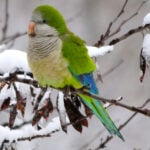 The Traveling BirdJune 26, 2025Can You Name 5 Parrot Species That Are Living Wild in the USA?
The Traveling BirdJune 26, 2025Can You Name 5 Parrot Species That Are Living Wild in the USA?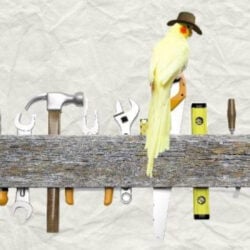 Bird BehaviorJune 26, 2025How is it Parrots Are Problem Solvers Social Animals and Even Use Tools?
Bird BehaviorJune 26, 2025How is it Parrots Are Problem Solvers Social Animals and Even Use Tools?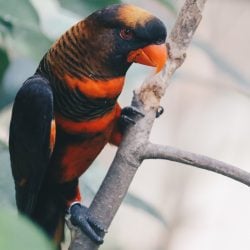 Bird & Parrot AnatomyJune 25, 2025How a Tiny Chemical Modification Makes Parrots Nature’s Living Paintings
Bird & Parrot AnatomyJune 25, 2025How a Tiny Chemical Modification Makes Parrots Nature’s Living Paintings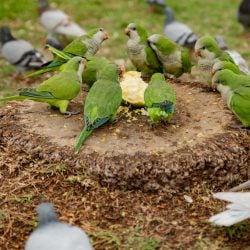 PigeonsJune 20, 2025How Do Parrots Thrive in Cities Outside Their Native Habitats?
PigeonsJune 20, 2025How Do Parrots Thrive in Cities Outside Their Native Habitats?
